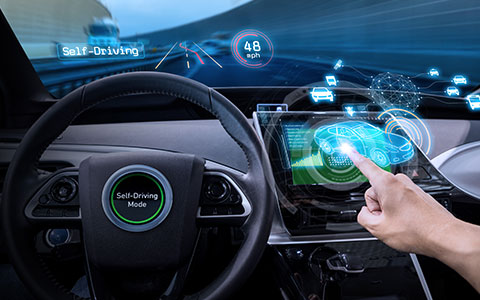
Car Safety Technologies that May Save Your Life [Video]

(DESCRIPTION)
Scott Humphrey, Travelers Safety Specialist.
(SPEECH)
SCOTT HUMPHREY: One day, cars may be able to drive themselves. And hopefully, we'll all be safer for it.
(DESCRIPTION)
A round white robot on the floor hits Humphrey's foot. Text, New Car Technology.
(SPEECH)
But not yet. While there are great new technologies available, it's up to us humans to use them safely. Today, we're talking about three in particular, blind spot monitoring, lane departure warning, and smart cruise control. Smart cruise control and blind spot monitoring use sensors to help you detect and avoid other vehicles.
(DESCRIPTION)
An animation depicts a car on the road with sensors gathering data as to proximities to other vehicles.
(SPEECH)
Almost like having an extra set of eyes on the road.
Lane departure warning uses cameras to actually read the lines of the road and alert you if you're drifting out of your lane. With all those extra sensors and cameras, we're bound to stay safe, right? Well, not so fast, the technology is great but it isn't perfect. For example, bad weather can hamper the signal. And some drivers may rely on the sensors too much and stop looking out for themselves. So don't over rely on this helpful technology, always remain alert and keep your eyes on the road. After all, you're the one who's in control
(DESCRIPTION)
Humphrey pushes the button on the top of the device.
(SPEECH)
for now at least. Share the safety with your friends and family.
(DESCRIPTION)
#ThinkSafe. Text, Get more safety tips at Travelers dot com slash ThinkSafe.
(DESCRIPTION)
The information in this video is intended for use as a guideline and is not intended, nor does it constitute, legal, technical or professional advice. Travelers does not warrant the adherence to any recommendations, best practices, or guidelines will result in a particular outcome. In no event will Travelers or any of its subsidiaries or affiliates be liable to anyone who has access to or uses the information provided in the video.
We take it for granted, the automatic way we take the wheel and set out to drive from Point A to Point B expecting to have a smooth, uneventful ride. Since the introduction of the automobile, driving has been a convenience that has transformed our lives. But driving comes with no guarantees of avoiding mishaps, and unseen, unpredictable safety challenges can occur.
Fortunately, in the many decades in which driving has become a given, a number of innovative technologies have been introduced to help make driving a safer experience every time.
It may not exactly be artificial intelligence, but some technologies are able to react to specific situations. Other technologies are like an extra set of eyes to help alert you to potential dangers, and help you to react in time to avoid harm to yourself, your vehicle or those around you as you drive. Here’s a roundup of some of the technologies available to bolster your driving experience.
Reactive and Responsive Features
Adaptive cruise control is the next-generation version of this technology that allows drivers to select and maintain a constant speed without using the accelerator. Adaptive cruise control systems can sense vehicles ahead and adjust your speed to keep a safe following distance. Some (but not all!) systems also incorporate emergency braking to help slow your vehicle to avoid a collision.
Another responsive technology that’s come along are adaptive headlights. Designed to help illuminate the road ahead during turns, adaptive headlights can help improve nighttime visibility on curved roads. As you turn, the lights adjust to illuminate the roadway ahead.
The Anti-Lock Braking System (ABS) has been around for years, to the point that many drivers may not realize this feature is a built-in safety requirement to keep their brakes from locking up when they stop. Even though ABS may not always help you stop more quickly, it can help you maintain control of your vehicle when you stop by preventing your wheels from skidding.
The Ease of Automation
There are some things that technology simply does better than our human limitations allow us to do ourselves. Take, for example, automatic lights. You’re driving into a tunnel. Before you have to flip a switch, the automatic light system in your car turns on your headlights to guide you through the temporary darkness. Once you emerge from the tunnel, the system turns off the lights, eliminating your need for reactive or proactive thinking and helping to keep your focus on your driving.
Likewise, the skillfulness required to park your car can be left to the car itself, thanks to automatic parking systems. Once you have placed your vehicle in a position where the automatic parking system can take over, multiple sensors detect obstacles and calculate steering angles while guiding your vehicle into a parking spot.
When You Don’t Have That 360-Degree View
Obstacle avoidance can be challenging from the driver’s seat, and innovators have taken that challenge seriously with technologies that help. Is there an object behind you? Backup alarms can alert you to it, and backup cameras can help you to see behind your vehicle in spots that otherwise might not be seen. Likewise, blind spot monitoring technology can give you a heads up when another car is in your blind spot. Sensors around your vehicle give you a warning when another car is detected. Depending on the vehicle, warnings can be visual, audible or tactile.
Maintaining control of your vehicle and being prepared for a possible crash have generated other technological advances – both new and tried-and-true. Among the ones to consider:
- Electronic Stability Control (ESC) has been around since the late ‘90s, and as of 2012 was required in all newly manufactured personal passenger vehicles sold in the U.S. The system can help detect when a skid is about to occur or is occurring, and can help you stay in control by selectively applying the brakes to different wheels.
- A Forward Collision Warning system may use radar, laser or camera sensors to detect when a crash is imminent. Once detected, the system alerts the driver to take action. Some of these systems are capable of braking automatically and preparing for a crash by pre-charging the brakes and tightening seat belts.
- Long drives and weariness can make it tough to stay alert. Lane Departure Warning Systems alert you with a warning if you drift out of your lane.
These technologies are changing how we drive and helping to make driving safer. But no matter how amazing these advances are, it is important to remember who is really in the driver’s seat. Drive at safe speeds, watch your blind spots and stay attentive, even if your vehicle has technology designed to help you with these important tasks.
More Prepare & Prevent

High-Tech Cars: What's New in Car Safety Features?
New technologies are bringing more safety features to help make your driving experiences safer and less stressful. Check out what's new!

Drowsy Driving Statistics and Facts
Sleepiness can come without warning, so drivers should prioritize getting enough sleep and avoid driving when they are fatigued.

5 Tips for Buying a New Car
It's tempting to buy a new car that looks great and is fun to drive, but you should also consider safety and insurance costs.